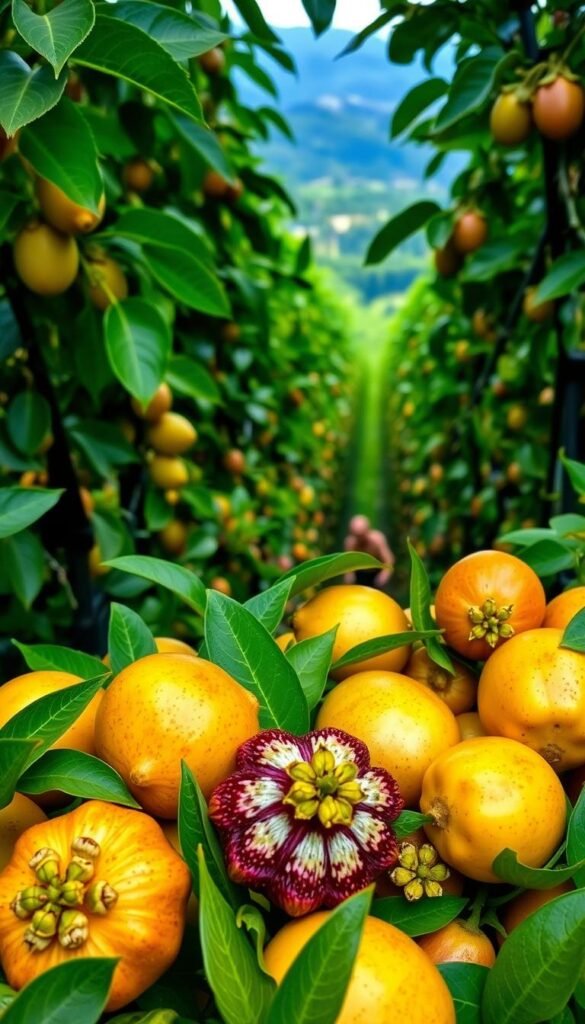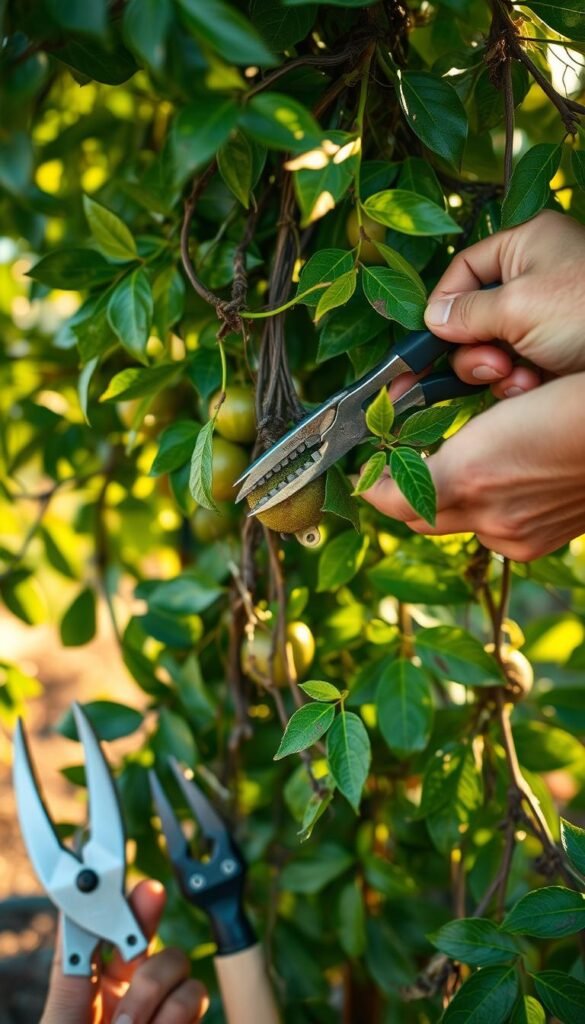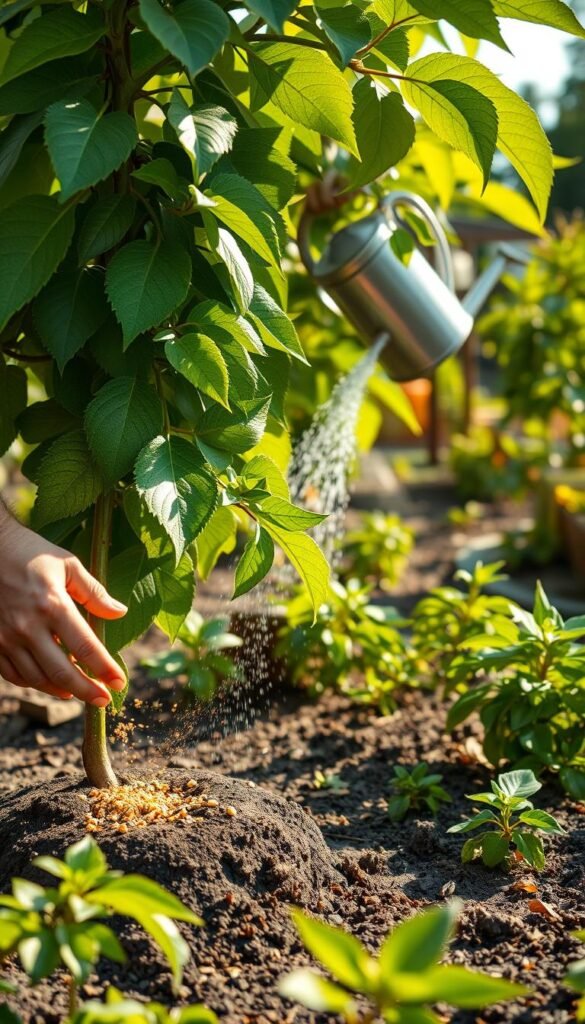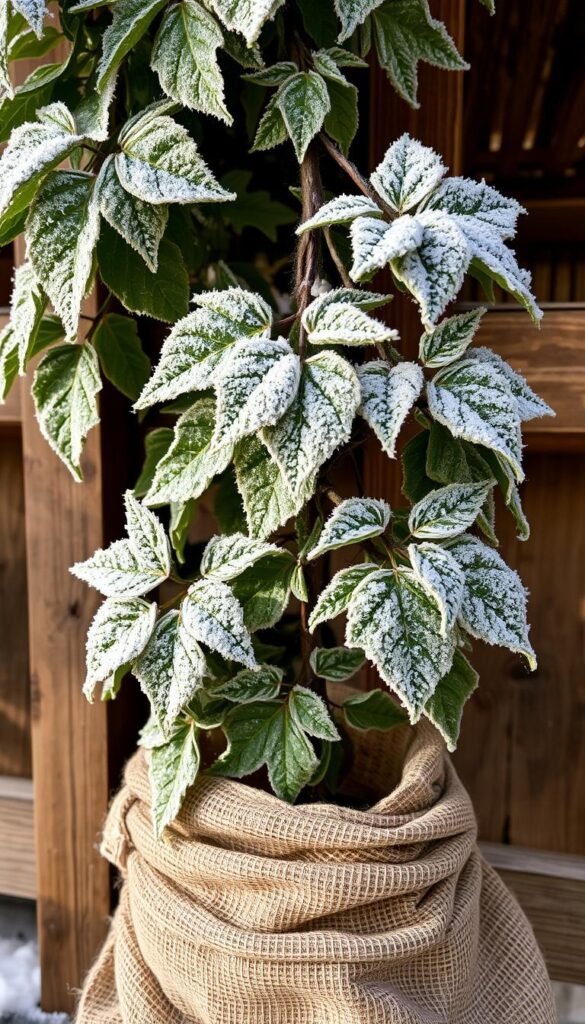Growing healthy, productive vines starts with knowing their needs. These fast-growing climbers stretch 10–15 feet tall and thrive in warm climates (zones 10–12). Full sun and consistent moisture help them flourish, but their rapid growth demands structure and attention.
You’ll notice these plants work on a tight schedule. Their prime fruiting window lasts just 3 years, so every season counts. Strategic pruning in spring sparks new growth where flowers and fruits develop—similar to grapevines. Without it, you’ll face tangled stems and fewer harvests.
Proper nutrition keeps vines vigorous. Balanced fertilizers support leafy growth early, while potassium-rich blends boost flowering later. In cooler areas, shielding roots from frost ensures survival until warmer days return.
The effort pays off beautifully. Mature vines produce striking purple-and-white blooms followed by tangy, nutrient-packed fruits. Whether eaten fresh or blended into recipes, they’re worth the careful planning your care routine requires.
Understanding Your Passion Fruit Plants

Successful cultivation begins with matching plant traits to your environment. With over 50 types of Passiflora edulis available, choosing the right fit impacts everything from pest management to harvest quality.
Recognizing Growth Patterns and Varieties
Purple varieties like ‘Black Knight’ deliver sweeter flavors but need extra pest monitoring. Their yellow counterparts handle tropical heat better but require a second plant for pollination. New stems developed after spring pruning become your main fruit producers within weeks.
These climbers thrive for 5-7 years, so smart gardeners plant replacements every 3 seasons. Grafted options like ‘Nellie Kelly’ combine disease resistance with vigorous growth, ideal for beginners.
Identifying Climate and Soil Needs
Zones 10-12 offer perfect conditions, but container growing expands possibilities. Temperatures below 65°F? Try cold-hardy Passiflora incarnata instead.
Test soil drainage before planting—water pooling longer than 30 minutes risks root damage. A 5.5-6.5 pH keeps nutrients accessible, while 3 inches of mulch protects shallow roots from temperature swings.
Essential Trimming Techniques for Vigorous Vines

Sharp shears and smart timing transform tangled climbers into productive powerhouses. Proper cuts balance growth with fruit production while preventing disease spread through crowded branches.
Annual Pruning: Timing and Methods
Early spring marks your prime window for shaping vines. As temperatures rise, plants redirect energy to new growth where flowers form. Warmer regions allow aggressive cuts—remove up to ⅓ of older stems. Cooler areas demand lighter trims to avoid shock.
Start by clearing dead wood and weak shoots. Cut lateral branches to 30cm lengths, leaving 3-5 buds. Keep your main leader intact, guiding it to the top of your trellis. This creates airflow channels that deter pests.
Renovating a Messy Vine and Shaping the Framework
Overgrown vines need bold action. Use loppers to clear tangled masses first. Identify your strongest vertical stem as the central leader. Remove competing shoots that divert resources.
Space secondary branches 30cm apart along the main vine. Trim fruit-bearing laterals to 15cm—this concentrates energy into fewer, higher-quality fruits. Pro tip: Pinch back tips reaching beyond your support structure monthly during the growing season.
Feeding and Watering Strategies for Optimum Growth

Smart nutrition and hydration practices turn vigorous vines into prolific producers. Timing matters: feed when plants actively grow, and water when they’re thirsty—not on a fixed schedule. Let’s break down how to balance these elements for maximum yield.
Choosing the Right Fertilizer and Compost
Start with a citrus-style fertilizer after spring pruning. Commercial growers prefer 10-5-20 NPK blends for their high potassium content. This nutrient boosts flower formation and fruit sweetness while preventing leafy overgrowth.
| Fertilizer Type | Best Use Time | Key Benefit |
|---|---|---|
| 10-5-20 NPK | Early Spring | Enhances flowering |
| Compost Tea | Monthly in Summer | Improves soil microbes |
| Magnesium Sulfate | When leaves yellow | Corrects deficiencies |
Layer 3 inches of mulch around the base—but keep it 6 inches from stems. Straw or shredded bark works best. Mix in aged compost quarterly to maintain soil structure.
Watering Essentials for Healthy Vines
Deep watering beats frequent sprinkles. Soak the root zone until moisture reaches 12 inches deep. During fruiting, check soil daily—if the top inch feels dry, it’s time to hydrate.
Drainage is non-negotiable. Test by pouring a gallon of water near the base. If pools linger over 30 minutes, amend the soil with sand or perlite. Container growers: use pots with multiple drainage holes.
Winter Protection and Frost Management Tactics

Guarding your vines against cold snaps becomes crucial as temperatures drop. Start tracking local forecasts daily when mercury dips below 65°F. Early warnings let you deploy defenses before frost strikes.
Insulating Your Plants With Frost Cloths and Mulch
Quality frost blankets trap heat effectively during sudden chills. Drape them over supports before sunset, securing edges with rocks. Combine this with 6-inch mulch layers around the base—straw works best. Keep insulation 4 inches from stems to prevent rot.
Container growers have an advantage here. When extreme cold looms, simply relocate pots to sheltered spots using proven winter-proof container gardening strategies. Water sparingly—dormant roots need less moisture.
Creating Microclimates and Selecting Cold-Tolerant Varieties
Position plants near south-facing walls or large stones. These surfaces absorb daytime warmth, radiating it overnight. Add temporary windbreaks using burlap screens when icy gusts threaten.
In cooler zones, try hardy Maypops (Passiflora incarnata). They withstand temperatures 10°F lower than tropical types. Always choose grafted plants for improved resilience—their robust root systems handle climate swings better.
Implementing Passion Fruit Garden Maintenance: Trimming, Feeding, and Winter Protection
Boost your harvest by integrating key practices tailored to your garden’s needs. Start each spring by pruning vines to encourage new growth, followed by feeding with potassium-rich fertilizer. Immediately apply mulch to retain moisture—this combo jumpstarts the season.
Step-by-Step Guide to Integrating Techniques
Train plants on sturdy 2m x 3m trellises using mesh or T-posts for support. Consistent care ensures lasting results. Pinch back excess growth monthly to direct energy into flowers and fruiting success. Replace older vines every 2-3 years for continuous yields.
Adapting Methods to Your Specific Garden Conditions
Adjust pruning intensity based on your climate—lighter cuts in cooler zones. Hand-pollinate if bees are scarce using a small brush. Yellow varieties need a different cultivar nearby. For precise trimming methods, follow this step-by-step passionfruit vine guide.
Monitor soil moisture weekly, adapting watering to local rainfall. Track plant responses and tweak your approach—they’ll reward you with tangy, nutrient-rich fruits.






